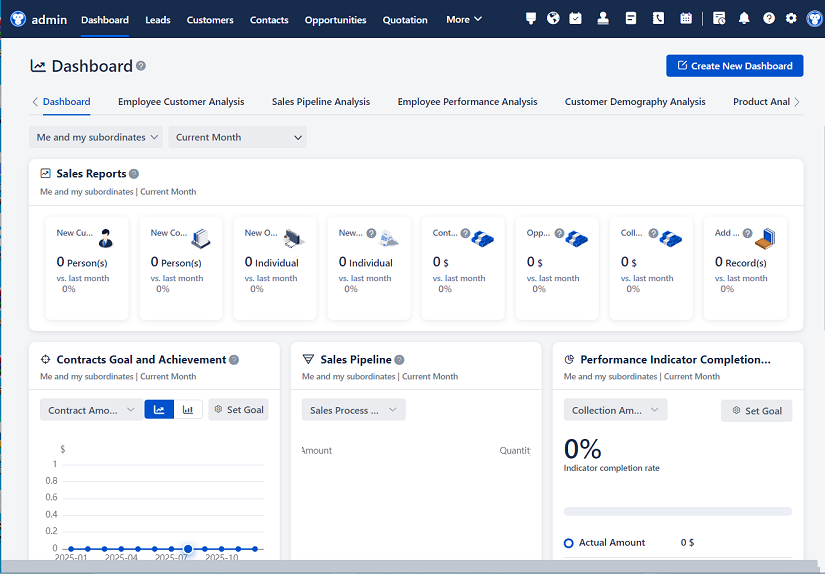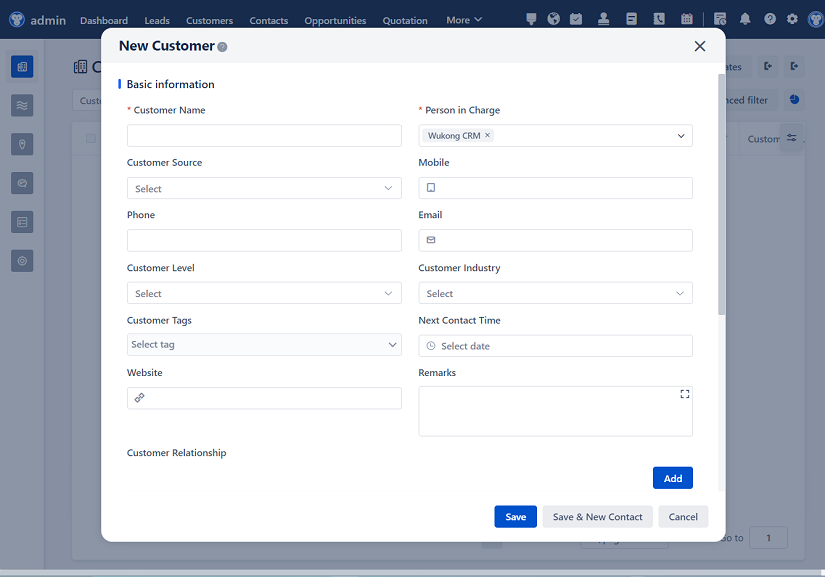
△Click on the top right corner to try Wukong CRM for free
Hey there! So, you're curious about how customer management and accounting can work together, right? Well, let me tell you, it's a pretty interesting combo. Imagine this: you've got a business, and you want to keep your customers happy while also making sure the books are in order. That’s where the magic of combining customer management with accounting comes in.
First off, let’s talk about what customer management is all about. It’s basically about building and maintaining strong relationships with your customers. You know, making sure they feel valued, getting their feedback, and keeping them coming back for more. It’s like being the best friend to your customers, always there when they need you.

Now, on the other hand, we have accounting. This is where you keep track of all the money stuff—revenues, expenses, invoices, and so on. It’s like being the financial guardian of your business, making sure everything adds up and that you’re not overspending or undercharging.
So, why would you want to combine these two? Well, think about it this way: if you can integrate your customer management system with your accounting software, you can streamline a lot of processes. For example, when a customer makes a purchase, the transaction can automatically be recorded in your accounting system. No more manual data entry, no more errors, and no more wasted time. It’s like having a super-smart assistant who does all the boring paperwork for you.
But it’s not just about saving time; it’s also about improving the overall experience for your customers. When your systems are integrated, you can get a 360-degree view of each customer. You can see their purchase history, their payment status, and even their preferences. This means you can offer personalized service, send out timely reminders, and address any issues before they become big problems. It’s like knowing exactly what your best friend likes and dislikes, and always being one step ahead.

Let’s dive a bit deeper into some of the benefits. First, you get better accuracy. When everything is automated, the chances of human error go down significantly. No more double entries, no more missed payments, and no more discrepancies. It’s like having a built-in fact-checker for your business.
Second, you get improved efficiency. With an integrated system, you can automate a lot of tasks. For example, you can set up automatic invoicing, payment reminders, and even follow-up emails. This means you can focus on more important things, like growing your business and taking care of your customers. It’s like having a personal assistant who never sleeps and always gets the job done.
Third, you get enhanced customer insights. When your customer management and accounting systems are connected, you can gather a ton of valuable data. You can see which products or services are the most popular, which customers are the most loyal, and which ones might need a little extra attention. This information can help you make better decisions, tailor your marketing efforts, and even predict future trends. It’s like having a crystal ball that tells you exactly what your customers want.
Now, I know what you’re thinking: “This all sounds great, but how do I actually do it?” Well, the good news is that there are plenty of tools and platforms out there that can help you integrate your customer management and accounting systems. Many CRM (Customer Relationship Management) systems, like Salesforce or HubSpot, offer integrations with popular accounting software like QuickBooks or Xero. These integrations are usually pretty straightforward, and many of them come with detailed guides and support to help you get set up.
If you’re a small business owner, you might be a bit hesitant to jump into something new. I get it; change can be scary. But trust me, the benefits are worth it. Start by doing a bit of research. Look at the different options available, read some reviews, and maybe even reach out to other business owners who have made the switch. They can give you some real-world insights and help you avoid any potential pitfalls.
Another thing to consider is the cost. While integrating your systems can save you a lot of time and money in the long run, there might be some upfront costs. You’ll need to factor in the cost of the software, any additional training, and possibly some consulting fees if you need help setting everything up. But remember, this is an investment in your business. The return on investment (ROI) can be significant, especially as your business grows and becomes more complex.
One of the key things to keep in mind is that integration is not a one-time thing. It’s an ongoing process. As your business evolves, your needs will change, and you might need to tweak your systems to keep up. This is where having a flexible and scalable solution comes in handy. Make sure the tools you choose can grow with your business and adapt to your changing needs.
Now, let’s talk about some of the challenges you might face. One of the biggest hurdles is data migration. If you’re moving from an old system to a new one, you’ll need to transfer all your existing data. This can be a bit tricky, and it’s important to do it carefully to avoid any data loss or corruption. Many software providers offer data migration services, so don’t hesitate to ask for help if you need it.

Another challenge is user adoption. Your team will need to learn how to use the new system, and there might be some resistance to change. To overcome this, make sure you provide adequate training and support. Show your team how the new system will make their lives easier and how it will benefit the business as a whole. Sometimes, a little bit of encouragement and a clear explanation of the benefits can go a long way.
Security is also a big concern, especially when you’re dealing with sensitive customer and financial data. Make sure the tools you choose have robust security features, such as encryption, multi-factor authentication, and regular updates. It’s also a good idea to have a backup plan in case something goes wrong. Regularly backing up your data and having a disaster recovery plan in place can save you a lot of headaches down the line.

Finally, let’s talk about the future. As technology continues to evolve, we’re likely to see even more advanced integrations and features. Artificial intelligence (AI) and machine learning (ML) are already starting to play a role in both customer management and accounting. Imagine a system that can predict customer behavior, suggest personalized offers, and even detect potential fraud. The possibilities are endless, and it’s exciting to think about what the future holds.
In conclusion, integrating your customer management and accounting systems can be a game-changer for your business. It can save you time, improve accuracy, and give you valuable insights into your customers. While there might be some challenges along the way, the benefits are well worth it. So, if you’re ready to take your business to the next level, give it a shot. You won’t regret it.
Q&A:
-
What is the main benefit of integrating customer management and accounting systems?
- The main benefit is that it streamlines your processes, reduces errors, and gives you a 360-degree view of your customers, making it easier to provide personalized service and manage your finances efficiently.
-
How can I get started with integrating my systems?
- Start by researching different CRM and accounting software options. Look for those that offer integrations, read reviews, and maybe reach out to other business owners for advice. Many platforms also provide detailed guides and support to help you get set up.
-
What are some of the challenges I might face during the integration process?
- Some common challenges include data migration, user adoption, and ensuring data security. It’s important to plan carefully, provide adequate training, and choose tools with robust security features to overcome these challenges.
-
Is it expensive to integrate these systems?
- There might be some upfront costs, including the cost of the software, training, and possibly consulting fees. However, the long-term benefits, such as increased efficiency and better customer insights, often make it a worthwhile investment.

-
How can I ensure the security of my customer and financial data?
- Choose tools with strong security features like encryption and multi-factor authentication. Regularly back up your data and have a disaster recovery plan in place. It’s also a good idea to stay updated on the latest security practices and updates.

I hope this helps, and if you have any more questions, feel free to ask!
Related links:
Free trial of CRM
Understand CRM system
AI CRM Systems

△Click on the top right corner to try Wukong CRM for free